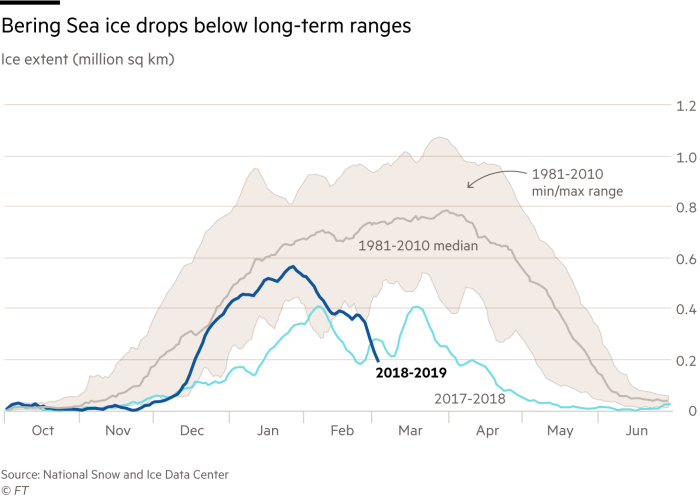Most of the stories don't mention what really makes this action stick out, the Arctic ice sheet as a whole seems to be recovering from the post-1979 lowest volume measurements recorded earlier in this decade with the sheet this year over 500K square kilometers larger than last year's extent and gradually thickening.
Since we first mentioned the Bering/Chukchi anomaly on Feb. 28 (top center in this view):

the Bering sea ice is almost completely gone on the Alaskan side south of the Seward Peninsula, which along with it's Russian counterpart, the Chukchi Peninsula marks the narrowest portion of the Bering Strait:
We'll try to get to that this week.
From Bloomberg via gCaptain:
The ice cover in the Bering Sea is at its lowest on record for this time of year after losing an area about the size of Montana at the height of winter.It’s the second consecutive year that the ice extent in the area has retreated at record pace. It shrank from 566,000 square kilometers (219,000 square miles) to 193,000 square kilometers between Jan. 27 and March 3, according to scientists at the National Snow and Ice Data Center in Colorado.Low ice levels impact local communities who rely on the ice to hunt for walrus and other wildlife during the winter, and the unprecedented change could also impact feeding habits of Arctic animals. And while that’s alarming to environmentalists concerned about global warming, ship owners carrying liquefied natural gas and other goods see it as an opportunity.Forbes chimed in with "Where Is The Ice That Should Be In The Bering Strait Right Now" on March 6 while the Financial Times' March 9 article "Winter ice hits record low in Bering Sea" was chock full of charts and maps including:
The Bering Sea is more susceptible to temperature fluctuations during the winter when thin ice moves further south and melts, but this year has been “extreme,” the boffins said.
“A major cause of the ice loss is the strong low pressure in the Bering Sea and the high pressure over northwestern Canada,” the researchers said. “Strong winds between these pressure centers drew warm air into the region from the south, inhibiting ice growth in the Bering Sea while also pushing ice to the north.”...MORE
